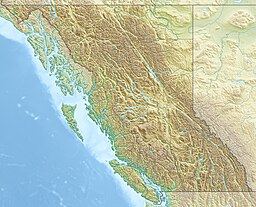Calm Channel
| Calm Channel | |
|---|---|
| French: Canal Calme | |
 Calm Channel | |
 Calm Channel surrounds the Rendezvous Islands (centre right) | |
| Location | Discovery Islands, British Columbia |
| Coordinates | 50°17′51″N 125°03′48″W / 50.29750°N 125.06333°W |
| Type | Strait |
| Primary inflows | Bute Inlet (north) Pryce Channel (east) |
| Islands | Rendezvous Islands |
| Sections/sub-basins | Drew Passage |
| References | [1] |
Calm Channel[1] is a channel located between several major islands of the Discovery Islands in British Columbia, Canada. The channel is an important waterway for boats transiting the archipelago.
Geography
[edit]The channel is flanked by Maurelle Island, Raza Island, Read Island, Sonora Island, Stuart Island, and West Redonda Island. Adjacent waterways include Cordero Channel and Bute Inlet (to the north), Raza Passage and Deer Passage (to the east), Lewis Channel and Sutil Channel (to the south), Whiterock Passage (to the southwest), and Hole in the Wall (to the northwest).
The segment of Calm Channel between the Rendezvous Islands and the northern tip of Read Island is known as Drew Passage.[2]
Hydrology
[edit]Water flows into Calm Channel primarily from Bute Inlet, and Pryce Channel via Deer Passage and Raza Passage. From Calm Channel, water flows outward with low velocity to various other channels and straits.[3] Due to this predominantly south-moving water flow, Calm Channel is not officially considered part of the Salish Sea proper, but it is considered part of its watershed.[4]
References
[edit]- ^ a b "Calm Channel". apps.gov.bc.ca. Retrieved September 29, 2020.
- ^ "Drew Passage". apps.gov.bc.ca. Retrieved September 30, 2020.
- ^ Foreman, M.; Stucchi, D.; Garver, K.; Tuele, D.; Isaac, J.; Grime, T.; Guo, M.; Morrison, J. (2012). "A Circulation Model for the Discovery Islands, British Columbia". Atmosphere-Ocean. 50 (3): 301–316. doi:10.1080/07055900.2012.686900. S2CID 128600793 – via ResearchGate.
- ^ Environmental History and Features of Puget Sound Archived May 13, 2009, at the Wayback Machine, NOAA-NWFSC
